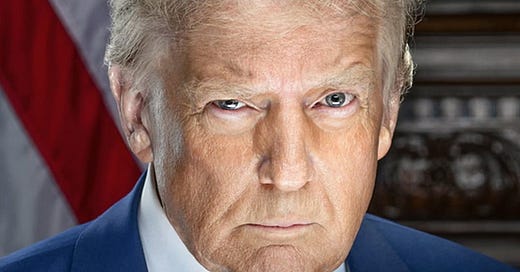President Trump has signed three executive orders imposing new tariffs on imports from Canada, Mexico, and China, marking a significant escalation in trade tensions. These tariffs, effective immediately, target key industries such as computer chips, pharmaceuticals, steel, aluminum, copper, oil, and gas, with additional levies on oil and gas set to take effect on February 18. Canada, however, will see a reduced tariff of 10% on its energy exports instead of the originally planned 25%. Trump also hinted at potential tariffs on EU imports, citing unfair trade treatment, though specifics remain unclear.
The tariffs could disrupt over $1.3 trillion in trade with America’s top three trading partners, which account for 41% of total U.S. goods trade. This move threatens to raise prices on everyday goods such as cars, lumber, smartphones, tequila, avocados, and fertilizer, potentially worsening inflationary pressures. While Trump dismissed inflation concerns, arguing that "tariffs don’t cause inflation; they cause success," economic analysts warn that American households could see an annual cost increase of approximately $1,300 due to higher consumer prices. In addition, a 1.5 percentage point drop in U.S. GDP and a potential recession in Canada and Mexico are expected as consequences of the trade war.
The United States-Mexico-Canada Agreement (USMCA), designed to ensure free trade among North American partners, now faces uncertainty as Trump’s tariffs push for a renegotiation of the deal, initially scheduled for July 2026. Meanwhile, international responses have been swift. Canadian Prime Minister Justin Trudeau has warned of economic fallout and is considering retaliatory tariffs, while Ontario Premier Doug Ford called Trump’s move "reckless." Mexico’s President Claudia Sheinbaum has vowed to defend Mexico’s economy and trade interests, signaling a strong pushback against the U.S. tariffs.
Within the U.S., reactions are divided along political and economic lines. Republican lawmakers, such as House Ag Committee Chairman GT Thompson, have defended the tariffs as necessary to level the global playing field for American producers. Democrats, including House Ag Committee Ranking Member Angie Craig, have criticized them, warning that the tariffs will hurt American farmers, increase consumer prices, and provoke retaliatory measures from trade partners. The agricultural sector, which heavily relies on trade with Canada and Mexico, faces higher fertilizer costs due to tariffs on Canadian potash. At the same time, food prices may rise as Mexican fruit and vegetable exports are disrupted.
Economists predict a significant impact on U.S. trade and industry, particularly as Canada and Mexico prepare countermeasures. Canada may focus on tariffing American goods sold in Canada, particularly those with readily available alternatives for Canadian consumers. Mexico, which sends 80% of its exports to the U.S., is also formulating a response. China remains a key target of Trump’s trade policy, particularly due to its exports of fentanyl precursor chemicals. However, analysts believe Trump may also use these tariffs as leverage for a future trade deal.
Trump’s latest tariff push marks a major shift in U.S. trade policy, with high economic and political risks. While supporters believe it will boost domestic industries, critics warn of inflation, supply chain disruptions, and strained international relations. The long-term impact of these tariffs will depend on whether Canada, Mexico, and China choose to comply with U.S. demands—or retaliate in ways that could harm American businesses and consumers.
Trump administration officials are encouraging Ukraine to hold elections by the end of the year, especially if a ceasefire with Russia is reached. Keith Kellogg, Trump’s envoy for Ukraine and Russia, emphasized the importance of elections even during wartime to uphold democracy. Trump and Kellogg are working on a plan to end the war but have not provided details.
Trump officials are debating whether to push for a ceasefire before negotiating a broader peace deal, with the idea that a newly elected Ukrainian president could lead long-term negotiations with Moscow. However, it remains uncertain how Ukraine would respond. President Zelenskyy has stated elections could only happen if the fighting stops and strong security guarantees are in place. As of now, the Trump administration has not formally asked Ukraine to hold elections.
Zelenskyy’s term was supposed to end in 2024, but elections are legally suspended under martial law. The Biden administration previously encouraged elections to uphold democratic norms, but Ukrainian officials resisted, arguing that elections could cause political instability, invite Russian interference, and divide the country. Some Ukrainian officials suspect Russia is using the election issue as a pretext to delegitimize Zelenskyy and disrupt peace talks.
The Kremlin claims it has not yet directly contacted Trump officials but has questioned Zelenskyy’s legitimacy in the absence of elections. Russia’s leader, Vladimir Putin, suggested that Zelenskyy revoke a 2022 decree banning negotiations with Russia before talks can proceed. However, Western officials warn that pushing for elections now could benefit Russia by weakening Zelenskyy’s authority and destabilizing Ukraine.
Skeptics doubt that a peace deal or elections will materialize soon, as both sides remain far apart on negotiation terms. Zelenskyy insists on U.S. and European security guarantees, including foreign military forces on the ground, as part of any ceasefire agreement. Meanwhile, Russia claims to be open to negotiations but has not shown substantive willingness to compromise.
Source: Reuters




The pot calling the kettle black. Putin questioning legitmacy?